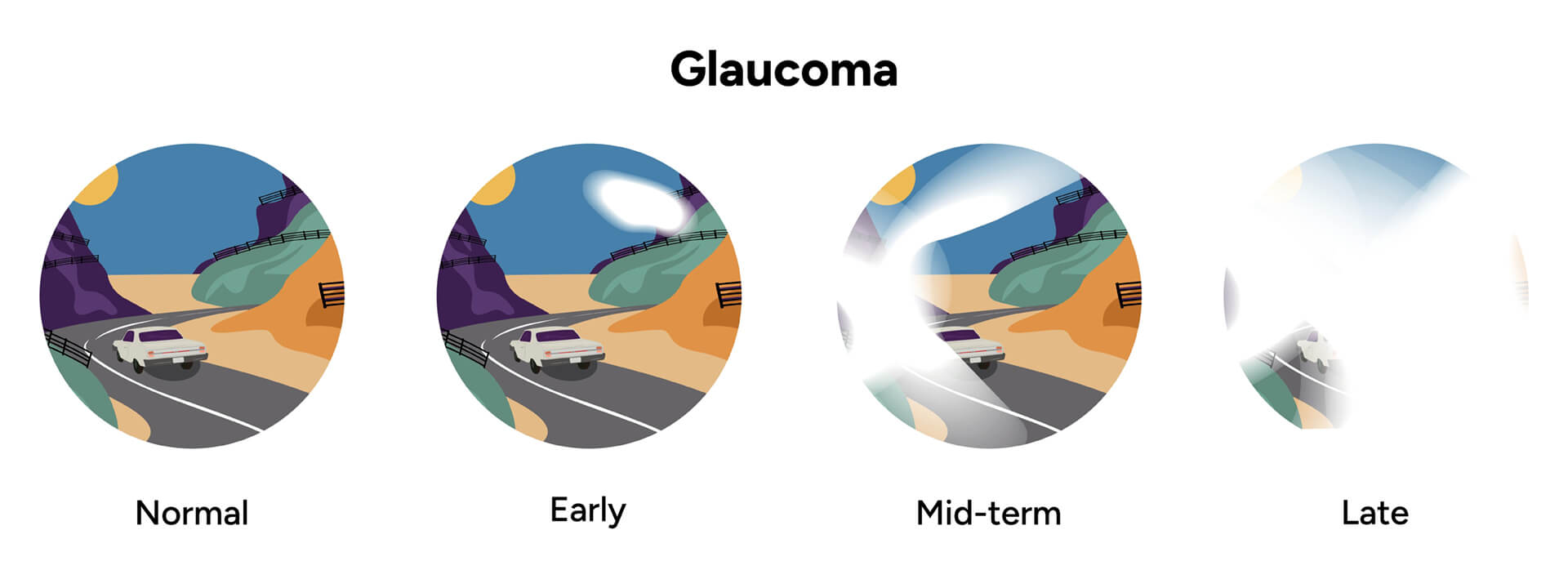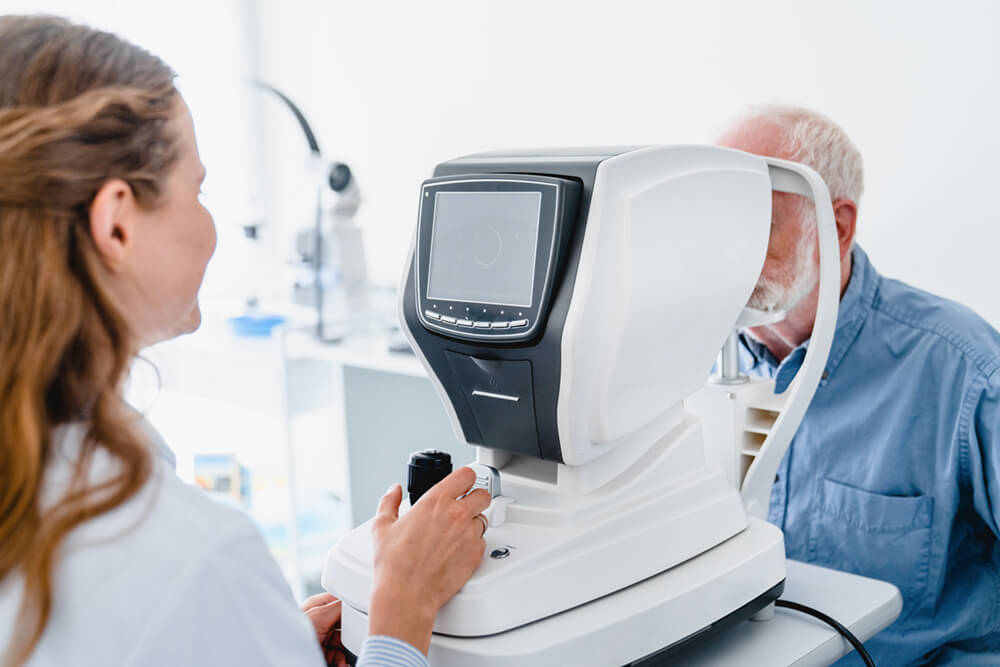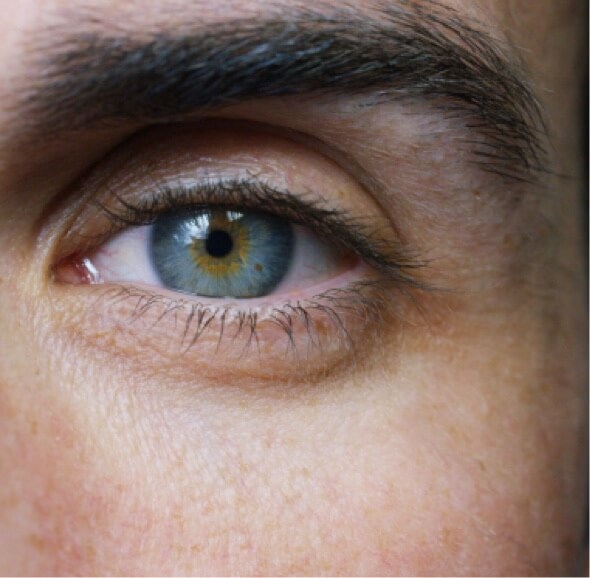Glaucoma
Glaucoma is often called the “silent thief of sight” because it can gradually steal your vision without you even noticing. This serious eye condition is one of the leading causes of blindness worldwide.
However, with early detection and proper treatment, vision loss from glaucoma can often be prevented or slowed significantly. At Eye Care Associates of New Jersey, we use advanced diagnostic technology and offer a full range of treatment options to help protect your vision and preserve your quality of life.
What Is Glaucoma?

Glaucoma is a group of eye diseases that damage the optic nerve, which connects your eye to your brain. Your optic nerve is like a cable made up of over one million tiny wires that carry visual information from your eye to your brain.
When glaucoma damages these “wires,” it creates blind spots in your vision that typically start in your peripheral (side) vision and can eventually affect your central vision if left untreated.
The most common form of glaucoma is related to increased pressure inside the eye, called intraocular pressure or IOP. Your eye constantly produces a clear fluid called aqueous humor, which normally drains out through tiny channels.
When this drainage system doesn’t work properly, fluid builds up and pressure increases, potentially damaging the optic nerve over time.
Types of Glaucoma
Open-Angle Glaucoma is the most common type, affecting a large majority of people with glaucoma. It develops slowly and painlessly, which is why many people don’t realize they have it until significant vision loss has occurred.
In this type of glaucoma, the drainage channels in the eye become less efficient over time, causing pressure to gradually increase.
Angle-Closure Glaucoma occurs when the drainage angle becomes blocked, often suddenly. This can cause a rapid increase in eye pressure and symptoms like severe eye pain, headache, nausea, and blurred vision. This type requires immediate medical attention.
Normal-Tension Glaucoma can occur even when eye pressure is within the normal range, suggesting that some people’s optic nerves are more sensitive to pressure or that other factors contribute to the disease.
Glaucoma Treatment Options

At Eye Care Associates of New Jersey, our approach starts with the least invasive treatments and progresses only when necessary. Each treatment plan is tailored to your specific needs, lifestyle, and stage of disease.
Prescription Eye Drops
Eye drops are commonly used in the treatment of glaucoma to lower eye pressure. These medications either reduce fluid production in your eye or improve drainage. Consistent use as prescribed is essential for effectiveness.
Laser Treatments
Selective Laser Trabeculoplasty (SLT) uses gentle, targeted laser energy to improve your eye’s natural drainage and lower eye pressure. SLT is often used as a first-line treatment for ocular hypertension and glaucoma. Studies have shown that it can be more effective than eye drops alone for some patients, and it may reduce or eliminate the need for daily drops.
Laser Peripheral Iridotomy (LPI) creates a small opening in the iris to improve fluid flow, particularly effective for angle-closure glaucoma.
Cataract Surgery
Cataracts are a natural clouding of the human lens that occurs with age. As cataract progresses, the lens increases in size, which can narrow the front chamber of the eye in some patients. This anatomical change may predispose individuals to angle-closure glaucoma by obstructing the eye’s natural drainage pathway. Cataract surgery is often performed to relieve this blockage and help open the drainage angle.
Minimally Invasive Glaucoma Surgery (MIGS)
These procedures lower eye pressure with less risk and faster recovery than traditional surgery. Many can be performed during cataract surgery.
Trabecular Bypass Stents (iStent, Hydrus) are tiny implants that help improve your eye’s natural fluid drainage pathways, making it easier for fluid to leave the eye and lowering eye pressure.
Goniotomy and Trabeculotomy create openings in the eye’s natural drainage system.
Canaloplasty enlarges the natural drainage canal using a microcatheter.
Xen Gel Stent is a small, flexible tube creating a new drainage under the eye’s surface.
Traditional Surgery
When glaucoma cannot be controlled with medications or less invasive procedures, traditional surgeries may be recommended. These options are typically reserved for more advanced cases or when very low eye pressures are needed.
Trabeculectomy creates a new drainage pathway using the eye’s own tissue, allowing excess fluid to leave the eye and lowering eye pressure.
Tube Shunt Implantation uses a small tube and drainage plate that are implanted to help fluid drain from the eye, reducing pressure.
Are you at risk for glaucoma, or has it been more than a year since your last comprehensive eye exam? Schedule your glaucoma screening at Eye Care Associates of New Jersey in Bergen County, NJ, today and take the first step in protecting your sight for years to come.









